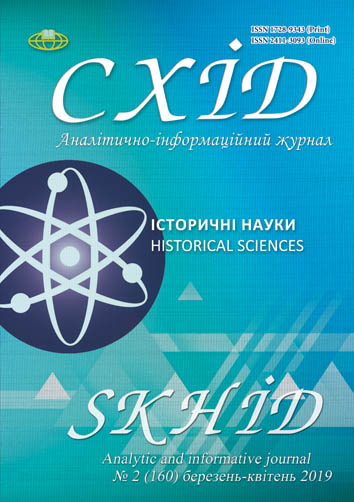Stalingrad strategic offensive operation (19.11.1942 - 02.02.1943): factors of success of tank for surrounding and destruction of large factions of enemy
DOI:
https://doi.org/10.21847/1728-9343.2019.2(160).164799Keywords:
Stalingrad strategic offensive operations, front line, tank corpsAbstract
Author in this article continuous publications on the Battle of Stalingrad, revealing the role of army armored troops of Red Army during the breakthrough of the enemy’s defense and surroundings of the 6th and 4th tank armies during the Stalingrad strategic offensive operation in the autumn-winter of 1942-1943, as the only one operation of the southwest, Don and Stalingrad fronts. The importance of groups of tanks of direct support of the infantry during the breakthrough of the enemy's defense and mobile units (tank and mechanized corps) during the completion of the breakthrough of the main enemy's defensive zone and the development of success inside of the enemy lines have been analyzed. The experience of the association of three tank corps for closer interaction under the general leadership of one of these commanders was singled out, which was the basis for the formation in the spring of 1943 of tank armies of a uniform composition.
Downloads
References
Adam, V. (1967). Trudnoye resheniye. (translat. from deuth). Moscow. (In Russian).
Busch, R. (2016). Survivors of Stalingrad: Eyewitness Accounts from the 6th Army, 1942-1943. London, 256 p. (In Enlish)
Doerr, H. (1955). Der Feldzug nach Stalingrad. Versuch eines operative Uberblickes. Darmshtadt. (In Germ)
Dopros voyennykh prestupnikov (1961). Voyenno-istoricheskii zhurnal. No. 4. p. 89 (In Russian).
Fuller, J. F. C. (1948). The Second World War. London, 659 р. (In English)
Glantz, D. M. and Jonathan, M. (2017). House Stalingrad (Modern War Studies). Kansas, Abridged, 640 p. (In English).
Haupt, Werner. (1997). Army Group North. The Wehrmacht in Russia 1941-1945. In: Schiffer Military History. Atlegen, 247 р. (In English).
Haupt, Werner. (1998). Army Group South. The Wehrmacht in Russia 1941-1945. In: Schiffer Military History. Atlegen, 259 р. (In English).
Hellbeck, J., ed. (2015). Stalingrad: The City that Defeated the Third Reich. Public Affairs, 512 p. (In English)
History of Wars and Military Art (1970). Moscow: Voenizdat, 560 p. (In Russian)
Isayev, A. V. (2008). Stalingrad. Beyond the Volga there is no land for us. Moscow: Yauza, Eksmo, 448 p. (In Russian).
Korennoy perelom v khode Velikoy Otechestvennoy voyny (noyabr 1942 - dekabr 1943) (1961). Istoriya Velikoy Otechestvennoy voyny Sovetskogo Soyuza 1941-1945 gg. Vol. 3. Moscow: Voenizdat, 662 p. (In Russian).
Kratkoye opisaniye pleneniya shtaba 6-y nemetskoy armii vo glave s yeye komanduyushchim general-fel'dmarshalom Paulyusom v Stalingrade chastyami 64-y armii Donskogo fronta 31 yanvarya 1943 g. (1959). Voyenno-istoricheskii zhurnal, № 2. (In Russian).
Manstein, Е. von. (1955). Verlorene Siege. Bonn, p. 384. (In Germ).
Mellentin, F. V. (2005). Tank battles of 1939-1945: combat use of tanks in World War II (translat. from germ). Moscow: AST; SPb.: Polygon, 437 p. (In Russian).
Morzik, F. (1961). German Air force Airlift Operations. USAAF Historical division. P. 195. (In English).
Newton, S. (1994). German battle tactics on the Russian front. 1941-1945. In: Schiffer Military History. Atlegen, 333 p. (In English).
Operatsii Sovetskikh Vooruzhennykh Sil v period korennogo pereloma v khode Velikoy Otechestvennoy voyny (19 noyabrya 1942 g. - dekabr 1943 g.) (1958). Operatsii Sovetskikh Vooruzhennykh Sil v Velikoy Otechestvennoy voyne 1941-1945 gg. Vol. 2. Moscow: Voyenizdat, 518 p. (In Russian).
Prikazy narodnogo komissara oborony SSSR 22 iyunya 1941 g. 1942 g. (1997). Russkiy arkhiv: Velikaya Otechestvennaya: Vol. 13 (2-2). Moscow: TERRA, 448 p. (In Russian).
Rodin, A. G. (1958). Koltso okruzheniya. In: Bitva za Volgu. p. 134. (In Russian).
Rokossovsky, K. K., ed. (1965). Velikaya pobeda na Volge. Moscow: Voenizdat, 528 p. (In Russian).
Rotmistrov, P. A. (1963). History of military art. Vol.2. Moscow: Voenizdat, 720 p. (In Russian).
Samsonov, A. M. (1989). Stalingradskaya bitva (4 ed.). Moscow: Nauka, 604 p. (In Russian).
Stavka VGK: Dokumenty i materialy: 1942 god. (1996). Russkiy arkhiv: Velikaya Otechestvennaya: Vol. 16 (5-2). Moscow: TERRA, 624 p. (In Russian).
Strokov, A. A. (1966). History of military art. Moscow: Voenizdat, 398 p. (In Russian).
Tippelskirch, K. (2001). Istoriya vtoroy mirovoy voyny 1939-1945. Moscow: AST, 796 p. (In Russian).
Vasilevsky, A. M. (1965). Nezabyvayemyye dni. Voyenno-istoricheskiy zhurnal. No. 10. (In Russian).
Voronov, N. N. (1963). Na sluzhbe voyennoy. Moscow: Voenizdat, 434 p. (In Russian).
Werth, A. (2001). Rossiya v voyne 1941-1945 gg. (Translation from English). Moscow: Voenizdat, 664 p. (In Russian).
Wieder, I. (1965). Katastrofa na Volge. Vospominaniya ofitsera-razvedchika 6-y armii Paulyusa (Translat. from German). Moscow: Progress, p. 51-53. (In Russian).
Zhilin, P. (1958). Rokovyye resheniya. Moscow: Voenizdat, P. 166. (In Russian).
Downloads
Published
How to Cite
Issue
Section
License
Copyright (c) 2019 Leonid Kryvyzyuk

This work is licensed under a Creative Commons Attribution-NonCommercial-NoDerivatives 4.0 International License.
1. Authors bear responsibility for the accuracy of facts, quotations, numbers and names used.
2. Manuscripts are not sent back.
3. The publisher does not always agree with the authors' opinion.
4. The authors reserve the right to authorship of the work and pass the first publication right of this work to the journal under the terms of a Creative Commons Attribution-NonCommercial-NoDerivatives 4.0 International License. This license allows others to distribute (copy) the published work for non-commercial purposes, provided there is mandatory attribution to its authors and a link to the first publication in our journal.
5. The authors have the right to conclude separate supplement agreements that relate to non-exclusive work distribution in the form in which it has been published by the journal (for example, to upload the work to the online storage of the journal or publish it as part of a monograph), provided that the reference to the first publication of the work in this journal is included.

